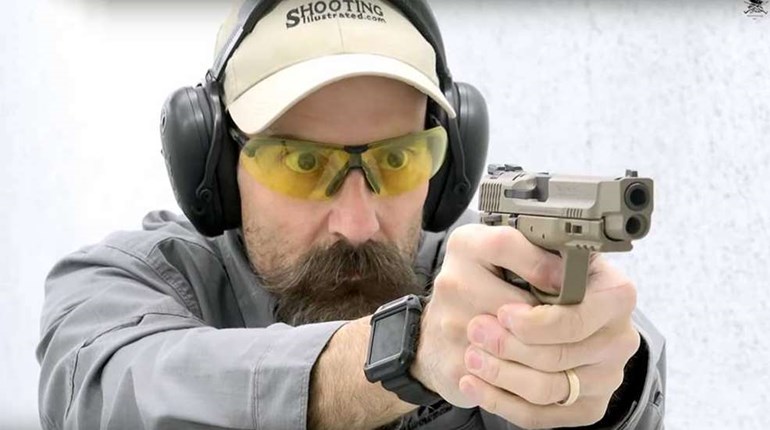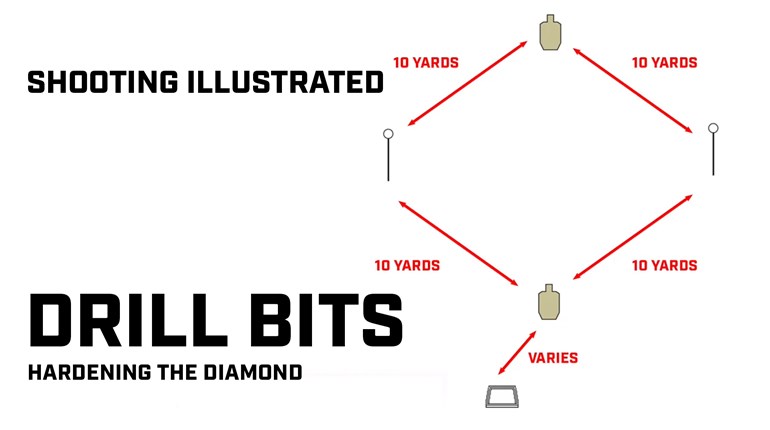
Environmental conditions add an interesting dynamic to any shooting discipline. Much of the popularity of precision rifle competitions and long range comes from the challenge of reading and adjusting for wind. Kestrels and ballistic solvers provide significant amounts of useful information. Even so, not everyone has these tools or can use them on the firing line. What do you do then?
I asked former U.S. Army Marksmanship Unit Service Rifle Team Head Coach, Sgt. 1st Class Walter Craig, for some answers. Craig has been with the AMU since 2004 and has served as a shooter, instructor, line coach, head coach and section leader. Distinguished in Service Rifle, Craig also enjoys shooting Extended Long-Range (ELR) competitions for fun and personal training.

Craig’s greatest accomplishment—coaching the 2018 AMU Service Rifle team to a national record in the 2018 National Trophy Team Match. The record was previously held by the U.S. Marine Corps Rifle Team since 2006. This record was broken in 2021 by USAMU Greenwood with a score of 2971-155X under Sgt. Forrest Greenwood, Craig’s protégé. This was Greenwood’s first time as head coach during a major national championship for an across the course team. Craig served as team captain while Greenwood coached the team to victory.
Before offering any insight, Craig gave a disclaimer, “As we move through this article, I need to highlight everything I will discuss is a culmination of knowledge derived from a lifetime of shooting, making mistakes, evaluating and learning from each specific mistake, refining data and applying it to the next day. I do not endorse any specific products, but I will have to discuss specific equipment and techniques.”

TRIGGERNOMETRY
Craig’s intelligence, focus and knowledge is undeniable. His approach to determining wind corrections echoes this, including considerable time spent studying wind patterns before heading to the line to shoot or coach. “Initially, I estimate the low and high values of the wind velocity in miles per hour,” he said. “I shoot an azimuth in the direction of fire, then I shoot another azimuth directly into what I see as the predominant condition. The next step is to subtract these angles and take the SIN of this value. This will give you what I refer to as the deflection value and crosswind component at this specific angle. I also run values at the angle of least deflection and most deflection. Once you have identified all these data points and know the low end, midpoint and high end of the bracket, all you have to do is watch conditions and see which one is most predominant.”

I never thought I’d have a real-life use for trigonometry. I asked for further clarification.
“The first azimuth I shoot is in the direction of fire (at Camp Perry, the best I can remember was 359), the next azimuth is into the wind’s predominant condition (last time I coached at Camp Perry predominant was from 320). In this example, I’d take 359 - 320 = 39 degrees, which is my angle of attack.” You always subtract the angle of the azimuth into predominant condition from the angle of the direction of fire. Picture a clock face or compass for a visual aid. Craig’s next step is to take the SIN of the angle of attack. In this case it is 0.629320, rounded up to 0.63.
“At this angle of attack, you need 62 percent of a full-value deflection,” added Craig. “You can figure a full value wind at speed and then multiply by 0.63 (your deflection value at said angle). It all starts with an azimuth in the direction of fire, then an azimuth into the wind. Subtract your azimuth into the wind from the direction of fire to get your angle of attack in degrees. Then take SIN of this number to get your crosswind component.”
Craig provided some examples to show it doesn’t take a large angle to begin significantly increasing the crosswind component.

Once you’ve found a full value number and multiplied by the crosswind component as described above, you can factor in wind speed. While the readily available laminated charts will work well for beginner and intermediate shooters, Craig frequently uses a Kestrel as a tool. “The best technique I’ve used to calibrate my eyes with what flags are saying is to have someone go downrange on a training day and stand near each flag with a Kestrel and call wind speed every 15 to 30 seconds,” said Craig. “You will quickly develop images of what standard range flags look like at different speeds. During data collection, you can annotate characteristics such as the angle of the flag relative to the pole, when the tip starts to point upwards occasionally (non-stop) and when the middle part of the flag starts to rise up. For mirage, you can say that it varies from boil, then you’ll see a lateral drift and at approximately three m.p.h., mirage will complete lay over flat. From four to approximately 15 m.p.h., dependent on atmospherics, you will see the levels of mirage compress and speed up. Above 15 m.p.h., or at whatever speed you lose contact or it’s intermittent, I turn my spotting scope upwind and can usually pick up changes in the air that would be in front of my target shortly.”
This leads to several other discussions. To convert what you see to MOA, multiply the observed wind speed by the corresponding drift value at that yard line. A drift value specifies the amount of drift in certain conditions at a certain location. Sadly, this is not a hard and fast number. “This number changes with air density,” explained Craig. “The thinner the air the less deflection per m.p.h., the thicker the air, the more deflection per m.p.h.” The classic way to obtain drift value is through fastidious data book records and extrapolation. Modern science has brought the Kestrel, which can identify exact drift values in left-to-right and right-to-left winds for a specific gun and load, though Craig cautions about relying too much on one or the other. It’s important to have backups.
He then summarized the process. “I run it at location with my K5700 Elite. I calibrate at location and set up my direction of fire. I then run my full-value numbers at 10 m.p.h. from three and nine. I take that number and divide by 10. This gives me an exact drift value in MOA/m.p.h. from both sides. In example, our 600-yard ammo drift value usually varies from 0.47 to as much as 0.54 MOA/m.p.h. This means that at 10 m.p.h. in one condition, you’ll need 4.7 MOA, and in the latter, you’d need 5.5 MOA.”
WIND BRACKETING
Another key component of successful wind reading is bracketing, which Craig has mentioned several times.

“Bracketing the wind is simply establishing low, mid, and high values on any given range, day and condition to identify which portion is predominant,” Craig said. “I typically stay in the middle third of an established bracket. When the lower and upper thirds come around, I’ve found it’s best to wait it out. The only exception is time constraints—some match conditions require much more waiting than others. Worst case, if I’m down on time and since I already have numbers for both ends, I’ll adjust and shoot outside my chosen third of my bracket. Bracketing is important as it is the foundation of a solid plan. Lacking the data points I mentioned previously, your only option is to just go shoot, spotter chase and hope for the best.”
Craig encourages others to work off what they know. He often doesn’t use exact numbers, focusing instead on what he knows the wind speed is not more than or less than, and choosing the midpoint. “Utilizing this technique has served me well over the years, anyone can do it,” he pointed out.
As a visual aid, Craig often drafts a scale graph of the landscape from the viewer’s perspective looking at the range from the right side, a technique he learned from his longtime friend Walter Stroman. “I start by obtaining elevation numbers at firing points and prominent terrain features downrange that include low, mid and high points as I walk downrange,” said Craig. “Once I have all these numbers, I take a sheet of standard graph paper—it usually works out to be five feet above ground level per square—and plot known data points starting with the firing line and working downrange. Once these are complete, I plot the trajectory of the exact bullet and muzzle velocity used out to 1,000 yards. Once all this is done, you can figure out how high the bullet is above ground level all the way the target.” People are also generally more comfortable with what they know. Some rely on mirage more than wind flags and vice versa.
The truth is that both are important. It’s key to remember that flags are generally always present whereas mirage can come and go with conditions. Craig recommends training each session with one of the two and switching off in order to fine-tune both skills.
WIND ALWAYS MATTERS
Besides placing too much value on one method of wind reading, another mistake shooters make is assuming wind does not matter at 200 and 300 yards. According to Craig, “Wind reading is critical at all stages of fire. For example, the average drift values in MOA/m.p.h. at 200, 300 and 600 yards would normally look like 0.19, 0.24, and 0.48, respectively. A light five m.p.h. full-value wind is worth one MOA, 1.25 MOA and 2.5 MOA respectively. Keeping your groups centered on target is critical to obtaining maximum scores.”

Sometimes keeping groups centered may include favoring during certain conditions. This has factored into Craig’s rapid-fire coaching technique. “Instead of calling impacts after the shot as most do, I give shooters a hold based on changing conditions before each shot as I track the changes. Scores across the board were much better in tough conditions using this technique—shooters do not need to hear when the last shot (in the past) impacted. Once again, it boils down to keeping shooters centered, relaxed and letting them shoot groups.”
While everyone may be looking for the “secret sauce,” Craig revealed that it doesn’t exist. “I personally do not think anyone has the ‘magic eye.’ I believe we all see the same indicators, what varies is how people interpret, analyze and make decisions.”



































